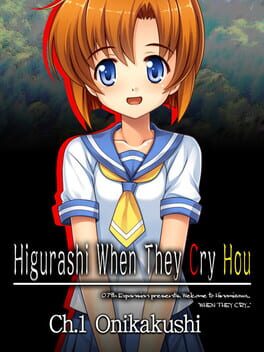This review contains spoilers
In a medium known for slow starts, Higurashi’s is one of the most infamous. Onikakushi has 12 chapters, and the mystery only gets going about halfway through Chapter 6. The prior chapters are devoted to slice of life hijinks which took me about 3 hours to get through (and would probably take longer for a slower reader). The extended slice of life opening is very contentious. By anyone’s standards it’s a long time for a story to “get going”, but if you’re expecting lots of murder based on the promotional material or the faster-paced 2006 anime it might become tedious. I don’t blame readers who get annoyed by this opening, but I think many might have the wrong mindset for it. If we view the slice of life scenes as a facade then they’re obviously gratiutous. I think this is the expectation many have for Higurashi - that the slice of life scenes only exist to be subverted. It’s become a pretty common gimmick in anime, especially ones labelled with the term “deconstruction”. But if Higurashi were aiming for a facade, why would it open by telling us where things are going? I think whether or not you enjoy the slow start, it’s worth engaging with it as a deliberate choice. What I noticed pretty quickly is that this isn’t written by someone who thinks of this as an easy way to build up a sense of normality that can be quickly subverted. There’s clearly a sense of admiration for the slice of life genre, and this is the main reason why it is longer than it “needs” to be. My personal defense for this opening is that it has a sense of sincerity to its character interactions and goofy humour that makes it a lot more enjoyable than a facade ever could be. The indulgence in the scenes of these friends just hanging out and playing games builds a sense of genuine comfort and routine. Ryukishi encourages an active engagement in these scenes - the feeling is as if you’re being welcomed into this friend group as Keiichi is. I think the best way to read Onikakushi and subsequent Higurashi chapters is to try and approach the slice of life sections on their own terms, rather than just waiting on the main plot to start. Having finished the entire series, I’d also argue that the slice of life sections are much more important than they initially appear. While there is some narrative foreshadowing, I’m mainly suggesting this from a thematic and dramatic perspective.
The second half of Onikakushi is where the series kicks off the psychological horror that it’s known for. In continued defense of Higurashi’s slice of life I find that the psychological horror plotting is pretty standard, and that it’s the horror’s synthesis with the opening section that makes it special. Onikakushi is one of those “is the main character under threat or are they just crazy?” storylines. The best of these will make either outcome equally horrifying, and this is what Onikakushi excels at. Ryukishi is excellent at tragedy, and it’s the slow destruction of the comfort and routine experienced in the first half that makes this chapter genuinely upsetting to read. The scene where Rena suddenly confronts Keiichi captures this fear I have of my friends suddenly turning on me. It also goes the other way - I’m afraid of no longer being able to trust my friends for whatever reason. The two key scenes for me are when Rena repeatedly says “I’m sorry” outside of Keiichi’s house and when Keiichi directly confronts Mion. In these scenes we’re painfully reminded of the bonds being broken here. Are Rena and Mion using their bond with Keiichi to emotionally manipulate him, or is Keiichi destroying these bonds out of his own paranoia and causing emotional distress for his friends? The personal investment in the characters and their friendship makes these questions a lot more painful to ask than they would otherwise. While the chapter is filled with really tense moments, I find it more depressing than it is scary. The chapter makes it really apparent that the synthesis of slice of life and horror is tragedy.
The second half of Onikakushi is where the series kicks off the psychological horror that it’s known for. In continued defense of Higurashi’s slice of life I find that the psychological horror plotting is pretty standard, and that it’s the horror’s synthesis with the opening section that makes it special. Onikakushi is one of those “is the main character under threat or are they just crazy?” storylines. The best of these will make either outcome equally horrifying, and this is what Onikakushi excels at. Ryukishi is excellent at tragedy, and it’s the slow destruction of the comfort and routine experienced in the first half that makes this chapter genuinely upsetting to read. The scene where Rena suddenly confronts Keiichi captures this fear I have of my friends suddenly turning on me. It also goes the other way - I’m afraid of no longer being able to trust my friends for whatever reason. The two key scenes for me are when Rena repeatedly says “I’m sorry” outside of Keiichi’s house and when Keiichi directly confronts Mion. In these scenes we’re painfully reminded of the bonds being broken here. Are Rena and Mion using their bond with Keiichi to emotionally manipulate him, or is Keiichi destroying these bonds out of his own paranoia and causing emotional distress for his friends? The personal investment in the characters and their friendship makes these questions a lot more painful to ask than they would otherwise. While the chapter is filled with really tense moments, I find it more depressing than it is scary. The chapter makes it really apparent that the synthesis of slice of life and horror is tragedy.
